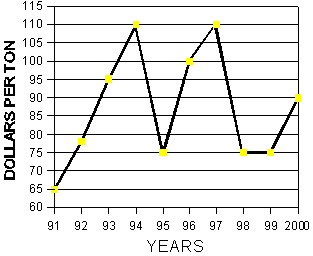Alfalfa Report
Yuma County, Arizona
October 9, 2000
Yuma County Office
2200 W. 28th Street, Ste. 102
Yuma, AZ 85364
(520) 726-3904
(520) 726-8472 FAX
Production Update:
PDF version, 14KB
Stand Replacement: The decision to replace alfalfa stands is based on stand establishment costs, opportunities in other crops, hay price, and yield of the alfalfa stand in question. Historical yields for the farm can provide a good idea whether or not a stand should be replaced. A stand should be replaced if plant density is less than 4 to 6 plants per square foot or if the number of stems is less than 40 per square foot. Optimum plant density can be considerably higher if the plants are not distributed uniformly. Renovating alfalfa stands by overseeding with alfalfa is rarely effective except in relatively large bare spots. Delay seeding alfalfa into a field previously in alfalfa by 2 to 4 weeks to avoid autotoxicity.
Insect Management: Infestations of silverleaf whitefly reduce alfalfa hay quality via honeydew contamination. Honeydew is a whitefly excrement composed of sugar, water and amino acids. Sooty molds, molds that produce black spores, often grow on honeydew. Sooty molds are not known to harm cattle or horses, but resemble molds from water damaged hay that produce toxins. Hay buyers are not likely to buy moldy looking hay or will discount the price of the hay. If insecticides were registered whitefly control in alfalfa, they would not be cost effective. An alfalfa resistant to silverleaf whitefly has developed at the University of California Desert Research and Extension Center. Seed increases are currently being completed in Imperial Valley, California and a new alfalfa variety resistant to silverleaf whitefly will likely be released next year.
Weed Control: Don't use trifluralin granules preplant unless you
are prepared to lose about half of the new stand. You need to wait until
the one trifoliate leaf stage for good crop safety. Any weeds that have
germinated by then will not be controlled.
| Market Summary |
High
|
Low
|
Average
|
Off grade
|
| Past 2 Weeks (Sept. 26 to Oct. 9, 2000) |
95
|
85
|
90
|
70-80
|
| Last Year (Sept. 26 to Oct. 9, 1999) |
80
|
70
|
75
|
40-70
|
10 Year Summary (September 26, to October 9, 1991-2000):

Issued in furtherance of Cooperative Extension work, acts of May 8 and June 30, 1914, in cooperation with the U.S. Department of Agriculture, James A. Christenson, Director Cooperative Extension, College of Agriculture and Life Sciences, The University of Arizona.
The University of Arizona is an equal opportunity, affirmative action institution. The University does not discriminate on the basis of race, color, religion, sex, national origin, age, disability, veteran status, or sexual orientation in its programs and activities.
Any products, services, or organizations that are
mentioned, shown, or indirectly implied in this web document do not imply
endorsement by The University of Arizona.
Information provided by:
Barry Tickes, btickes@ag.arizona.edu Extension Agent, Yuma County
Michael Ottman, mottman@ag.arizona.edu Agronomy Specialist
College of Agriculture, The University of Arizona.
Eric Natwick, etnatwick@ucdavis.edu UCCE Imperial County - Farm Advisor
University of California, Davis, CA.
Material written October 9, 2000.
Forages: Crop Mgmt | Soil Mgmt | Irrigation | Alfalfa Reports | Insects | Diseases | Weeds | Pesticides
Home | Other Crops | Forages
For more Arizona Production Ag Information:
Home | Cotton | Veggies| Forages | Grains | Citrus | Crop x Crop | Insects | Diseases| Weeds | Pesticides | News | Weather | Research | Photos | Contacts | General Info. | Site Map
Copyright © 2001 University of Arizona,
College of Agriculture and Life Sciences
Webmaster: Al Fournier (fournier@ag.arizona.edu)